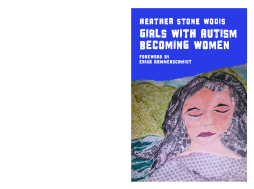
Additional Information
Book Details
Abstract
This insightful book investigates the experiences of seven women with autism as they transition from childhood to adulthood, and how they make sense of that journey.
Taken from the autobiographies of women including Liane Holliday-Willey and Temple Grandin, these accounts shine a light on issues unique to women with autism. Heather Stone Wodis provides a detailed and thoughtful exploration of their common experiences, and each story offers a new perspective that illuminates the diagnosis from a different angle. This is a fascinating look at how generational differences, such as access to the internet, can provide more avenues toward self-expression, political mobilization, and advocacy. It also explores the idea that, no matter the era, the unyielding support of family and a diagnosis in childhood can help girls with autism transition toward adulthood.
Dr. Heather Stone Wodis has a Ph.D in Disability Studies from the University of Illinois at Chicago. Her doctoral thesis formed the basis of this book. She has extensive experience in autism and special education and has worked as an ABA therapist.
Girls with Autism Becoming Women helps establish a historical tradition of memoirs and autobiographies by people on the autistic spectrum. All of the texts analyzed by Stone are written with the urgency of survival at stake by those who find themselves entrapped in various systems of neurotypical oppression. This is a helpful guide for teaching texts that can now be used in multi-disciplinary university classrooms and the discussion helps yield an understanding of neuroatypicality as a form of artistic living interdependently with others. Stone brings her background in Psychology, Sociology, and Disability Studies to bear on the importance of these works.
David T. Mitchell and Sharon L. Snyder, authors of Narrative Prosthesis: Disability and the Dependencies of Discourse and The Biopolitics of Disability: Neoliberalism, Ablenationalism, and Peripheral Embodiment
Wodis details how girls on the Autism Spectrum transition from children to adults, recognizing seven women as a strong 'minority within a minority.' Education, careers, sexual development, and social networks paired with qualitative, interpretive research methodology validate fist-person autie-biographies. Her unique approach relies on grounded theory with systematic, constant comparison. Using Rosemarie Garland-Thomson's situated theory, she socially contextualizes ASD from neuroqueer identity to religious constraints. I applaud her support of autism as an equally valid form of neurological embodiment. I highly recommend this book to those interested in the intersection of Autism Spectrum Disorder and female gender issues.
Telory D. Arendell, Associate Professor of Theatre and Dance, Missouri State University
Table of Contents
| Section Title | Page | Action | Price |
|---|---|---|---|
| Girls with Autism Becoming Women by Heather Stone Wodis | 3 | ||
| Foreword by Erika Hammerschmidt | 9 | ||
| Acknowledgments | 13 | ||
| List of Abbreviations | 15 | ||
| Preface | 17 | ||
| Introduction | 21 | ||
| Meet the Women | 41 | ||
| Education | 61 | ||
| Interests and Career Paths | 85 | ||
| Sexual Development and Romantic Relationships | 117 | ||
| Family, Friends, and other Networks of Support | 137 | ||
| Conclusion | 161 | ||
| Appendix 1: Severity Levels for Autism Spectrum Disorder | 167 | ||
| Appendix 2: Research Methods | 169 | ||
| References | 175 | ||
| Subject Index | 185 | ||
| Author Index | 195 | ||
| Blank Page |
